MARIANI’S
Virtual Gourmet
May
14, 2017
NEWSLETTER

❖❖❖
IN THIS ISSUE
DINING OUT IN BUDAPEST, Part Two
By John Mariani
NEW YORK CORNER
NISÍ ESTIATORIO
By John Mariani
NOTES FROM THE WINE CELLAR
WHAT I'M DRINKING NOW
By John Mariani
❖❖❖
DINING OUT IN BUDAPEST,
Part Two
By John Mariani

Central Market
Photo by Thaler Tamas
In his classic study The
Cuisine of Hungary (1971), George Lang
traced his country’s culinary beginnings very
precisely to 896 AD, when the Magyar tribes
arrived under Prince Árpád (right).  But Lang he goes on to say that,
“Hungary has always been, because of its
position between East and West, overrun and
invaded; and the occupiers have left indelible
marks on Hungarian cuisine.”
But Lang he goes on to say that,
“Hungary has always been, because of its
position between East and West, overrun and
invaded; and the occupiers have left indelible
marks on Hungarian cuisine.”
Sadly, that rich stewpot was put on a back burner
during the Soviet occupation from 1945 to 1991. Only
since then has the diversity of Hungary’s cuisine
bounded back, at first with little access to the
best ingredients but now in full flourish, which
is best seen in Budapest’s numerous markets.
The best known is the immense Central Market at
Fővám Square, built in 1897, now sprawling over
11,000 square feet on two floors, with scores of
stalls selling poultry, meat, fish, cheeses,
sausages, spices and vegetables, all of it
well-lighted, which makes an enormous difference
in the purveying of food. The profusion of foods
is in fact so vast that it is difficult to imagine
how the tenth or twentieth poultry stall can
compete, which goes for every segment. Of
course, the variety of paprika is astounding.
 Downstairs is where most
of the food stalls are, separated by long, wide
aisles. Upstairs
the stalls are filled with knickknacks, souvenirs
and cheap clothing, along with a swathe of fast
food places serving up hearty Hungarian fare at
very low prices.
There is also a nook of a wine bar that’s a
fun place to go after shopping. Open Mon.-Fri.
Downstairs is where most
of the food stalls are, separated by long, wide
aisles. Upstairs
the stalls are filled with knickknacks, souvenirs
and cheap clothing, along with a swathe of fast
food places serving up hearty Hungarian fare at
very low prices.
There is also a nook of a wine bar that’s a
fun place to go after shopping. Open Mon.-Fri.
In addition there are several other markets around
the city, each with its own character and size,
including Fehérvári, A Belvárosi, and Fény Street
on the Buda side.
As noted in an earlier issue, Budapest is now home
to many fine new restaurants that would rank with
the best in Europe,
joining older restaurants that followed in
the wake of the Soviet exit, including the elegant
Gundel, Remíz, with its lovely garden, and Krúdy
Vendéglö, with its deep wine cellar.
(Prices are in Hungarian forints, which is
currently 285 to the U.S. dollar.)
To read Part One of this story click
here.
Macesz Bistro 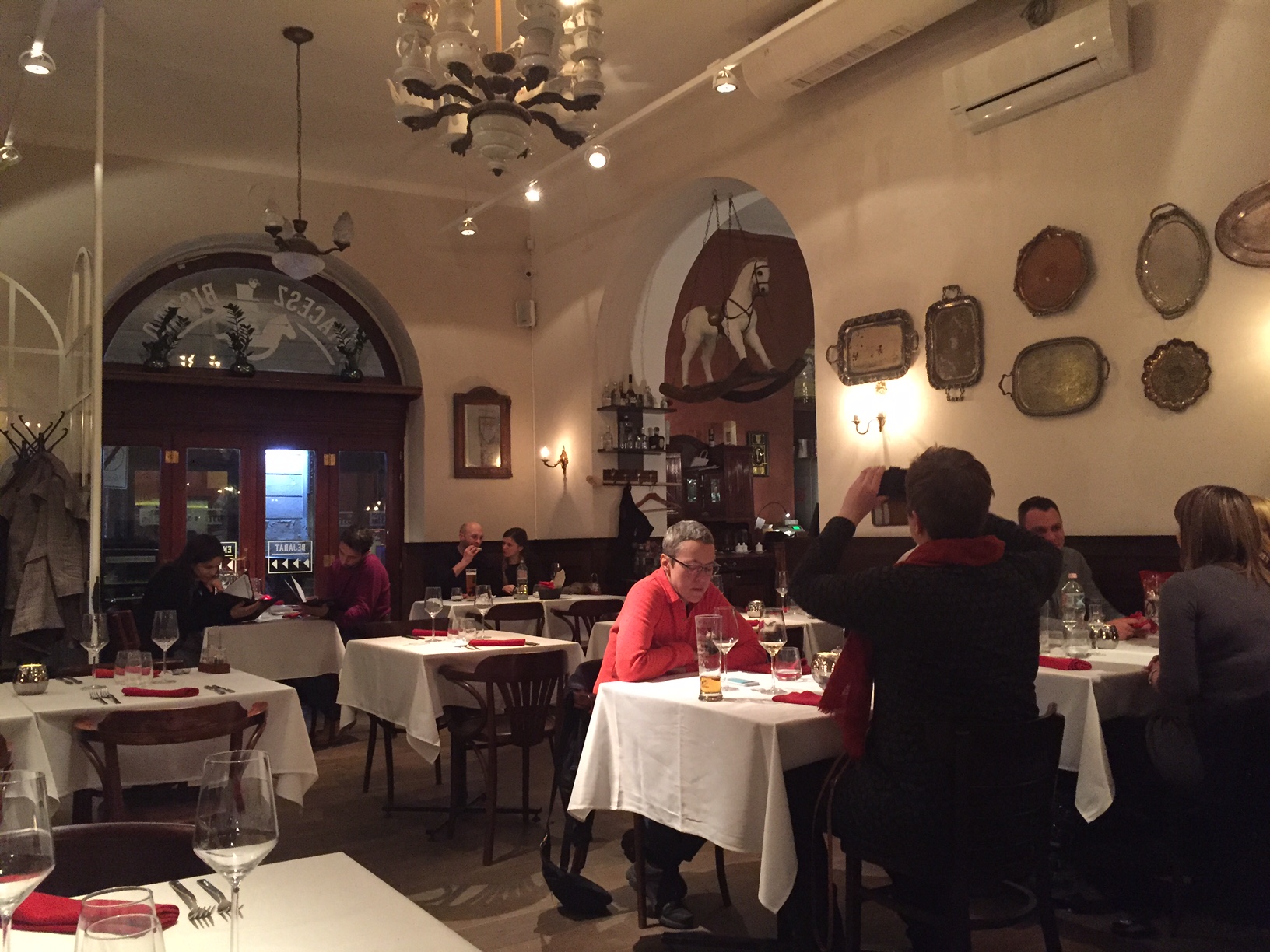
26 Dob Street
36-1-787-6164
There
is a slew of small, hidden away neighborhood
restaurants opening throughout the city, many in
the quickly developing 7th District. The
three-year-old Macesz Bistro is set on a narrow street in
Budapest’s Old Jewish section, not far from the
Great Synagogue.
Chef Ákos
Tasnádi changes his blackboard menu frequently
with seasonal specials, and not all of the items
are from Hungarian Jewish cookbooks, but all the
food is hearty, beautifully presented and served
with exceptional cordiality.
 The newly renovated
room, with an off-set bar area, is always cheery,
archways hung with a toy hobby horse, track
lighting, sconces and chandeliers adding to the
warmth of the room; old silver serving platters,
white tablecloths and red napkins evoke the
traditional cast of a pre-war Budapest. The
wine list teems with the best current Hungarian
The newly renovated
room, with an off-set bar area, is always cheery,
archways hung with a toy hobby horse, track
lighting, sconces and chandeliers adding to the
warmth of the room; old silver serving platters,
white tablecloths and red napkins evoke the
traditional cast of a pre-war Budapest. The
wine list teems with the best current Hungarian bottlings. English
is spoken with good cheer.
bottlings. English
is spoken with good cheer.
Macesz means “matzoh,” which
you’ll find in the bread basket, and it is a fine
way to start with tasty hummus (1,290 HF). Also
thoroughly traditional and prettily presented is a
plate of fried potato latkes with a sour cream
foam and watercress (1,290 HF). Order
foie gras pâté with sun-dried apricots (2,190 HF)
and you get an enormous slab, good for two people.
The confit of goose with pearl barley (1,290 HF)
is a very hefty dish indeed, succulent to the bone
and kept moist by the vegetable broth. Unexpected
and delicious is a lasagne made with matzo and
layered with many vegetables (3,290HF). The only
dish I didn’t think matched the rest was a dessert
of flodni,
made of thin pastry layered with apple, walnut,
poppy seed and jam (1,290).
There is a Jewish Traditional five-course dinner
at 7,900 HF, with wines 3,900 HF more, and a
Macesz menu of five courses at the same price.
Prices include
VAT and 13.5% service charge.
The
restaurant is open for lunch and dinner daily.
 21
Restaurant
21
Restaurant
Fortuna utca 21
36-1-202-21-13
Across the Danube on the
Buda side, 21 Restaurant—the name refers to the
card game and the address—offers the  very best of the Old and New worlds. Set
just a block form St. Mary’s Church in one of the
prettiest areas of the city, this charming
eight-year-old bistro might just as easily fit in
a less crowded arrondissement of Paris or a quiet
section of Greenwich Village.
very best of the Old and New worlds. Set
just a block form St. Mary’s Church in one of the
prettiest areas of the city, this charming
eight-year-old bistro might just as easily fit in
a less crowded arrondissement of Paris or a quiet
section of Greenwich Village.
It certainly
looks the part with its welcoming façade and an
interior broken into cozy sections with
well-lighted pale rough brick walls, very
comfortable gray rattan armchairs and brown
banquettes, well-set mirrors, and flowers on the
tables.
 Manager Márk Bense
speaks perfect English, which he uses to tell you
proudly about his all-Hungarian 30-label wine list
of small estates—an option unthinkable even ten
years ago, when investment just began coming back
to winemaking in Hungary.
Manager Márk Bense
speaks perfect English, which he uses to tell you
proudly about his all-Hungarian 30-label wine list
of small estates—an option unthinkable even ten
years ago, when investment just began coming back
to winemaking in Hungary.
There are specials,
seasonal and daily--I was there this winter--so
you might begin with Chef Lajos Lutz’s újházi, a
traditional deeply flavorful chicken soup (1,790
HF), or hortobágyi
chicken crȇpe colored with mild paprika (2,290
HF, or 2,960 HF). 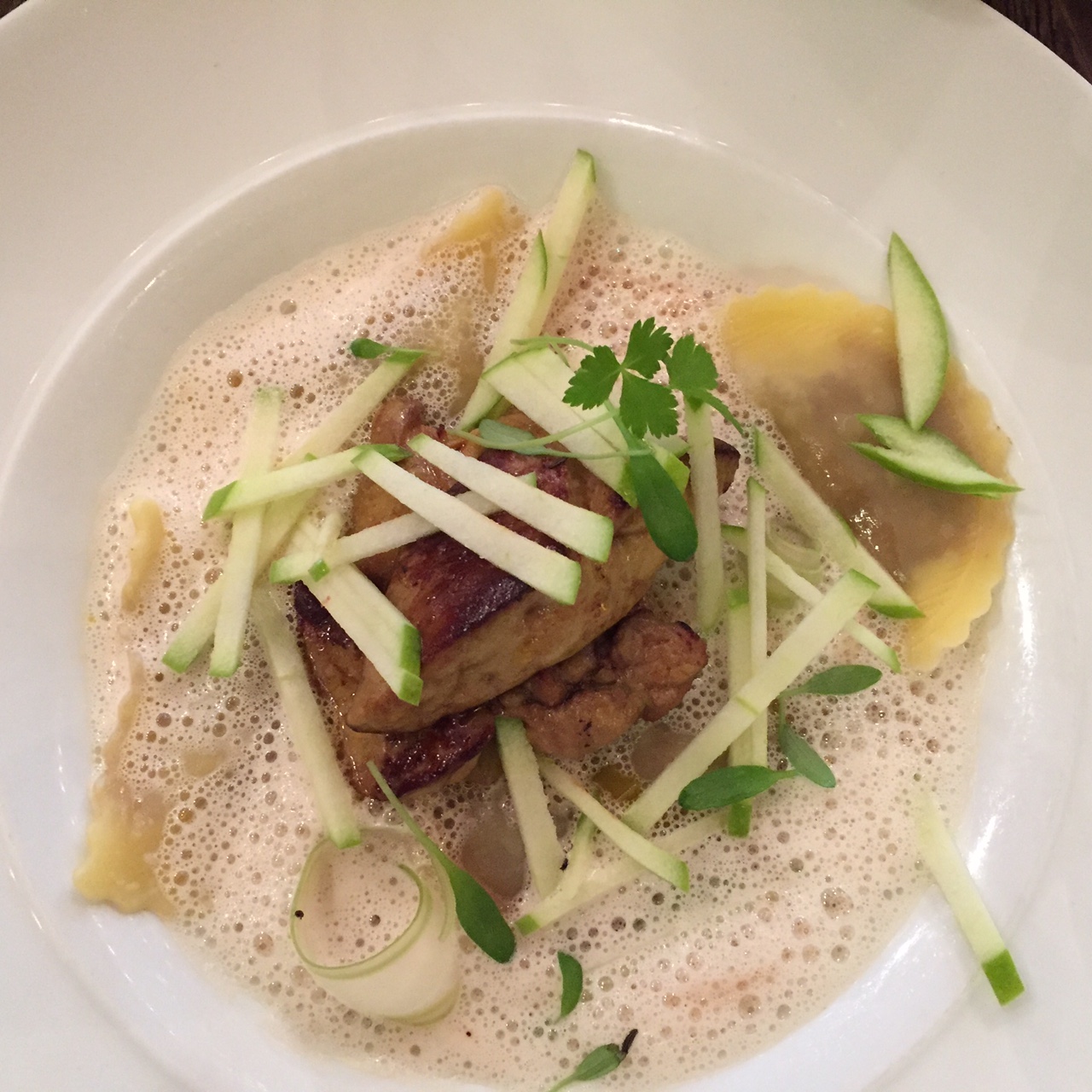 Hungary makes a good deal of foie
gras (much of it imported by France), and at 21 it
comes in the form of a velvety gras pâté drenched
with the marvelous Hungarian sweet wine Tokaji and
served on toasted
housemade brioche (2,940 HF).
Hungary makes a good deal of foie
gras (much of it imported by France), and at 21 it
comes in the form of a velvety gras pâté drenched
with the marvelous Hungarian sweet wine Tokaji and
served on toasted
housemade brioche (2,940 HF).
Delicate ravioli (right) stuffed with juicy duck
meat are afloat in a lovely green apple and celery
velouté with its own slab of foie gras (3,260),
and you’ll need a good appetite for the hearty
pig’s knuckle (left) that is roasted, then
deep-fried and served with gelatin cubes of pork
and sauerkraut (4,860 HF).
Desserts follow the same
pattern of gustatory generosity, and the whole
tenor of 21 is one of sheer, comforting pleasure.
Prices include VAT and a 13.5% service charge is
added to the bill.
The
restaurant
is open daily for lunch and dinner.
By John Mariani
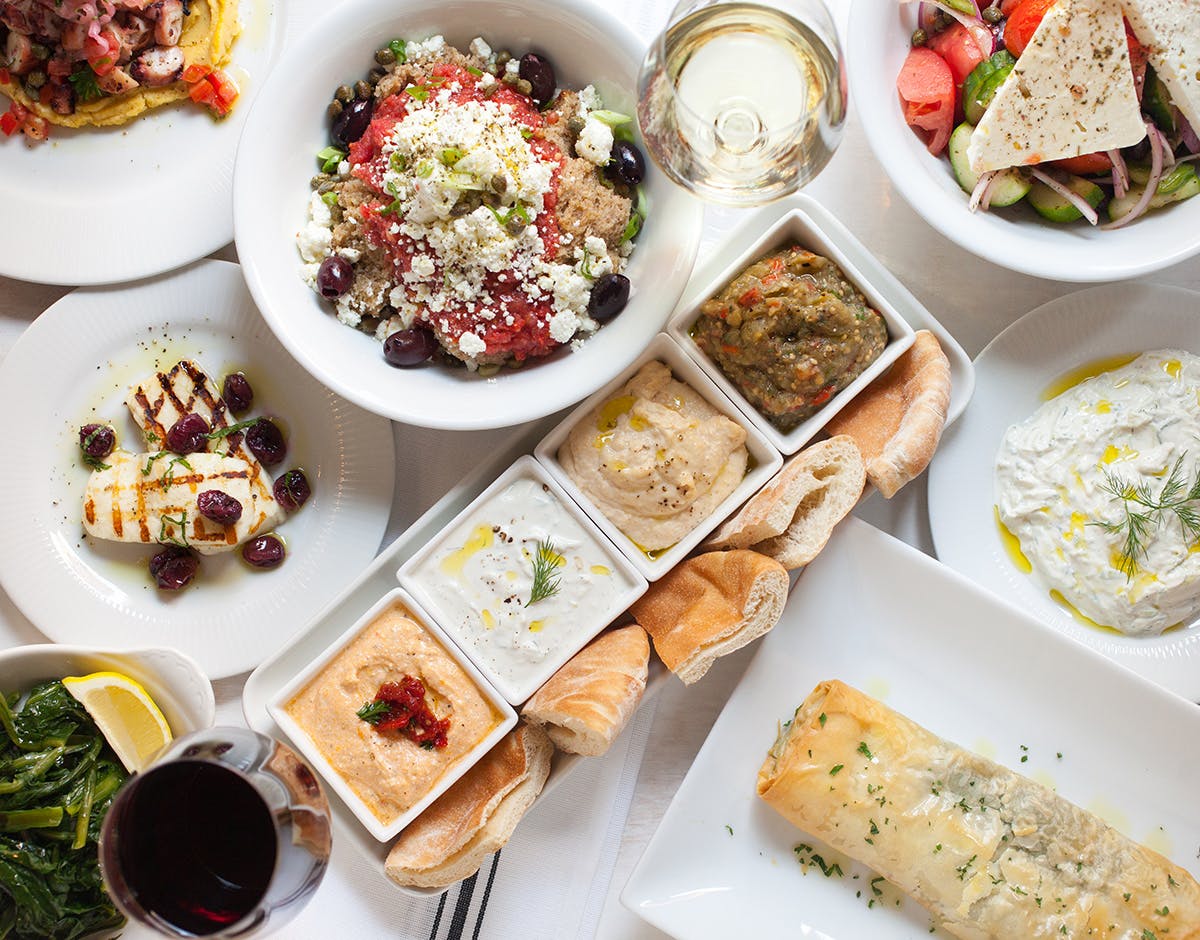
NISÍ ESTIATORIO
302 Bleecker Street (near Christopher Street)
212-727-7463
I’m beginning to think that Greek food is the most underrated cuisine in NYC, almost wholly neglected by the media. Perusing the NY Times listings, I found that none has been covered during the tenure of the paper’s main critic and only a handful by neighborhood stringers.
Which is not only too
bad but wholly myopic. Greek food is not only
some of the most delicious around but also fits
in with contemporary health and nutritional
recommendations to consume more seafood,
vegetables, olive oil, yogurt and much else that
falls under the so-called Mediterranean diet.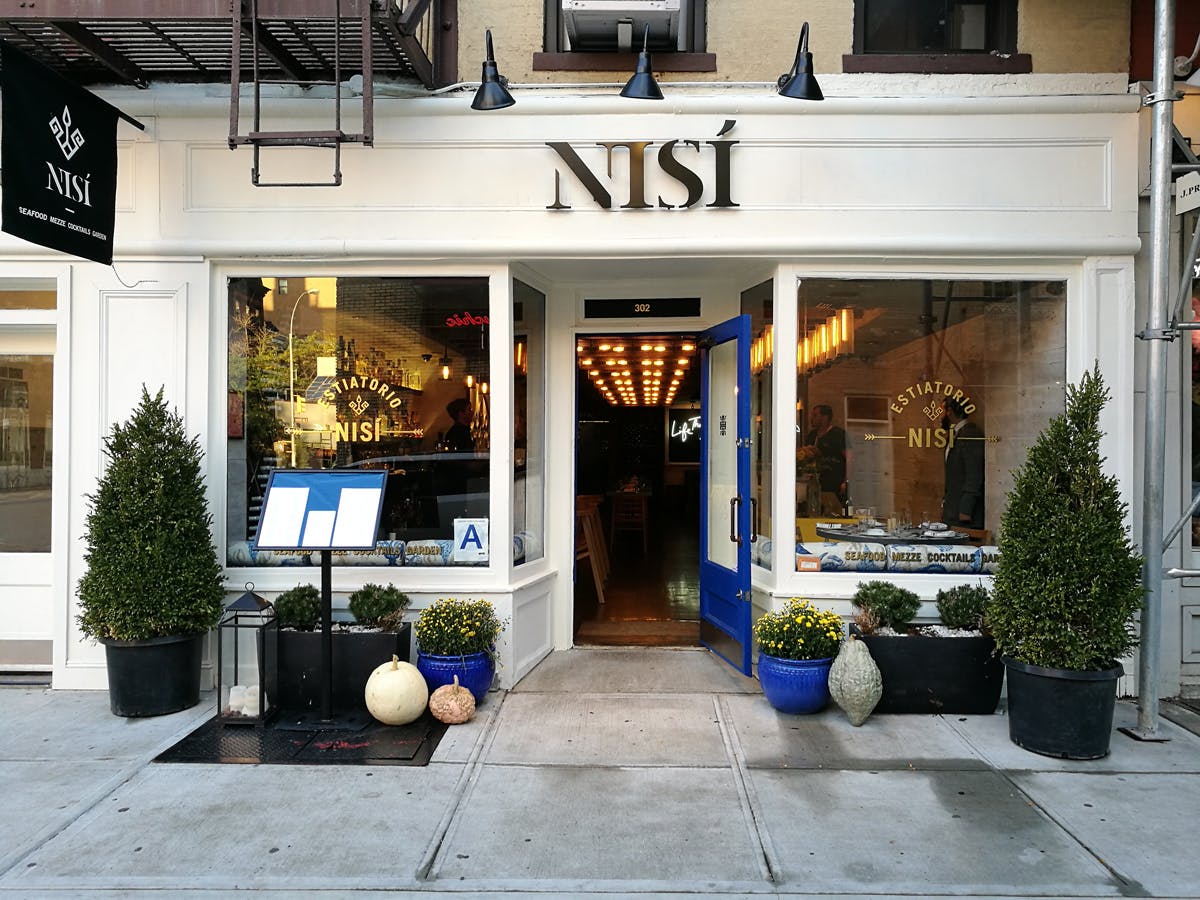
Manhattan has plenty of fine Greek restaurants, as does Astoria, where the Greek community makes up about 18% of the population. The brand new Nisi, in West Greenwich Village, is representative of a style of Greek cooking that evolved after Milos and Molyvos, in Midtown, broadened the seafood aspect of Greek menus and caused a significant upgrade in the quality of all ingredients.
Nisí is the creation of
partners Mike Himani and Andreas Kelemidis, along
with Chef Nikola Karvelas (below), a
handsome fellow who’s worked in some of the best
restaurants in Athens then Istanbul. Eventually
moving to the U.S. to cook at Avra and Anassa
Taverna, he is now manning the stoves  at Nisí—the Greek word
for island—and both inside and out it has a
delightful buoyancy of spirit. The
façade is done in the white and blue colors of the
Greek flag, leading to a raftered bar and front
dining room and on to an enchanting outdoor patio
ringed with Edison light bulbs. The
wait staff shows the same hospitality you’ll find
in the tavernas of the Greek isles, and the menu
is of a size that encourages lots of meze.
at Nisí—the Greek word
for island—and both inside and out it has a
delightful buoyancy of spirit. The
façade is done in the white and blue colors of the
Greek flag, leading to a raftered bar and front
dining room and on to an enchanting outdoor patio
ringed with Edison light bulbs. The
wait staff shows the same hospitality you’ll find
in the tavernas of the Greek isles, and the menu
is of a size that encourages lots of meze.
You are first brought toasty country bread and a
creamy taramosalata
spread, and there are several other spreads
available, served with pita bread (somewhat dry on
my visit). The
spanakopita
of spinach, scallions, leaks and dill-flecked feta
cheese wrapped in handmade phyllo ($15) is
colorful and very good, the Nisí zucchini and
eggplant chips served with tzatziki
($17) should be gobbled up by your party of four,
and the saganaki is a pan-fried orb of sheep’s
cheese ($14) that will go fast. Best of
all the mezes I tasted was a generous platter of
grilled octopus ($21) done in a red wine
vinegar with salty capers and a dash of oregano. I’ve
become accustomed to tender octopus in Greek
restaurants, but this one was extraordinary in
every way.
done in a red wine
vinegar with salty capers and a dash of oregano. I’ve
become accustomed to tender octopus in Greek
restaurants, but this one was extraordinary in
every way.
Every bit as good were fat, heads-on jumbo shrimp ($21) dressed lightly with lemon and olive oil and needing nothing more.
The special that evening was a silky, moist tsipoúra (gilt-head bream) impeccably grilled ($29). The mousakas ($29), done in the style of Astakos in western Greece, comes steaming in a ceramic dish as layers of eggplant, potatoes, zucchini and a lobster ragôut topped with a very rich béchamel sauce ($29).
Kopsidia ($56) is a generous assortment of meats, intended for two people and including grilled lamb chops, lamb sliders, lamb kebab, meatballs and chicken, with Greek fries, pita bread and tzatziki. The kebabs came off the best, for while the other meats were good, their amalgam seemed to suffer from all being plated without regard to their individual cooking times.
 For dessert
there is a fine baklava and a moist chocolate cake
with ice cream.
For dessert
there is a fine baklava and a moist chocolate cake
with ice cream.
Nisí’s wine list is conveniently on the back of the menu and is predominantly and proudly Greek, with plenty of top labels, most offered in a little carafe by the glass. Mark-ups are reasonable on the Greek wines; the international bottlings less so.
Right now, on a spring night, walking along Bleecker Street in Greenwich Village is one of NYC’s most delightful pastimes, with a restaurant in every other storefront. But that inviting white-and-blue façade of Nisí is one that will likely make you stop, peek in, and make the idea of dining outside in twilight as alluring as strolling through the winding pathways of Mykonos for the same reasons.
Open daily for dinner.
❖❖❖
By John Mariani
ARE CORK STOPPERS OBSOLETE?

As discussed in this column last week, “corked” wines—those tainted by a chemical due to a faulty cork—make up between five and fifteen percent of all bottles. That is an astounding failure rate in any industry short of North Korean missile tests.
Yet the appeal of cork stoppers continues to the degree that the vast majority of wines in the world, especially premium wines priced above $15, use corks. There must, you would think, be a very good reason. But, frankly, there isn’t.
 Corks have been used since Ancient
Greece in their ceramic amphoras (left), though
the practice lapsed in the Middle Ages in favor of
wood, wax and pitch, then returned to favor when
glass bottles appeared in the 17th century. Failure
rates considered, cork was still the best thing
available until the 20th century, when several
other closures were invented, including metal
screw caps, synthetic corks, and Teflon-coated
glass, all of which preclude any bottle cork
problem. So
why don’t wine producers use them?
Corks have been used since Ancient
Greece in their ceramic amphoras (left), though
the practice lapsed in the Middle Ages in favor of
wood, wax and pitch, then returned to favor when
glass bottles appeared in the 17th century. Failure
rates considered, cork was still the best thing
available until the 20th century, when several
other closures were invented, including metal
screw caps, synthetic corks, and Teflon-coated
glass, all of which preclude any bottle cork
problem. So
why don’t wine producers use them?
I ask this question of most
wine producers I meet and interview, and the
answer is almost always the same: Corks are more
... romantic.
Some of those producers warm to that idea,
though I’m never sure if they really mean it. Most
point the finger at consumers who have become
conditioned by the dubious romance of pulling a
cork from a bottle or who believe only cheap wines
have non-cork closures. Such people may never be
convinced that the ritual of finding the right
corkscrew, risking destruction of the cork,
getting cork bits in the wine, and sometimes
needing a superhuman strength to get the damn
thing out is hardly romantic in any way and may lead at
best to embarrassment and at worse to a complete
mess. Such
cork lovers always smile and mention the
celebratory “pop” of the cork when it comes out of
the bottle, giggling like teenagers when a
Champagne cork shoots across the room. They’re
the same people who find slicing off the top of
the bottle with a sword a giddy amusement (right).
the right
corkscrew, risking destruction of the cork,
getting cork bits in the wine, and sometimes
needing a superhuman strength to get the damn
thing out is hardly romantic in any way and may lead at
best to embarrassment and at worse to a complete
mess. Such
cork lovers always smile and mention the
celebratory “pop” of the cork when it comes out of
the bottle, giggling like teenagers when a
Champagne cork shoots across the room. They’re
the same people who find slicing off the top of
the bottle with a sword a giddy amusement (right).
Those who wouldn’t be caught dead serving a bottle with a “fake” cork or a screw cap do so out of abject fear they will be judged cheap by their friends. They insist that a screw cap on a bottle of Grand Cru Burgundy is like putting plastic covers on antique sofas, which is certainly not pretty but highly protective.
In fact, when E&J Gallo wanted to gain their Hearty Burgundy wines a little more respect, they switched from jugs to Bordeaux-style magnum-sized bottles and ditched the screw caps for corks. It didn’t make the wine taste any better.
I will bet you, however, if an avid wine lover purchased a case of, say, $125 per bottle California Cabernet and found every bottle—even half of them—corked, they would storm back to the wine store and demand a refund, which they will probably get; the store owner may then get a refund from his distributor, who eats the loss. All of which could have been avoided if the wines had been stoppered with a screw cap or imitation cork. Regarding the screw cap, “It’s the best technology for closing wine in a glass bottle,” says Thomas Henick-Kling, director of Washington State University’s Viticulture and Enology program, who did research on the subject.
 Well aware of
all this debate, the Portuguese cork industry has
redoubled its efforts to make a better cork. Formerly,
they bleached the corks but found that actually
increased the possibility of TCA (the chemical
compound that causes cork taint); then they used
hydrogen peroxide, irradiation and heat to destroy
mould. After being placed in plastic bags, the
corks are hit with carbon dioxide. These
techniques showed promise but have not eliminated
the TCA problem by a long shot.
Well aware of
all this debate, the Portuguese cork industry has
redoubled its efforts to make a better cork. Formerly,
they bleached the corks but found that actually
increased the possibility of TCA (the chemical
compound that causes cork taint); then they used
hydrogen peroxide, irradiation and heat to destroy
mould. After being placed in plastic bags, the
corks are hit with carbon dioxide. These
techniques showed promise but have not eliminated
the TCA problem by a long shot.
A somewhat more reasonable objection to screw caps
is that wine in a bottle can benefit from what is
called oxygen transmission, by which oxygen enters
the bottle through a cork, affecting the wine and
contributing to its development and aging. Makers
of big red wines insist their products definitely
need longer aging and a little oxygen. Fans of
corks contend screw caps allow no oxygen
transmission and synthetic corks not
enough. But it’s a transmission that may cause
other problems: Too much oxygen and you’ll have a
nasty oxidized wine; there’s no such thing as too
little.
not
enough. But it’s a transmission that may cause
other problems: Too much oxygen and you’ll have a
nasty oxidized wine; there’s no such thing as too
little.
But both synthetic cork and screw top makers have managed to allow some oxygen into the bottle. Indeed, a French company named Diam Buchage has even found a way to offer products with different oxygen transmission rates. Take your pick.
There is, to be sure, a vast number of producers who would love to switch to synthetic corks or screw caps. Back in 1997 Napa Valley’s highly regarded PlumpJack winery decided to bottle its finest Reserve Cabernet under a screw cap “in an effort to maintain only the highest quality wine.” Just this year Quady wines of Madera, California, switched most of its wines to screw caps, and most of the wines from Australia and New Zealand now use them.
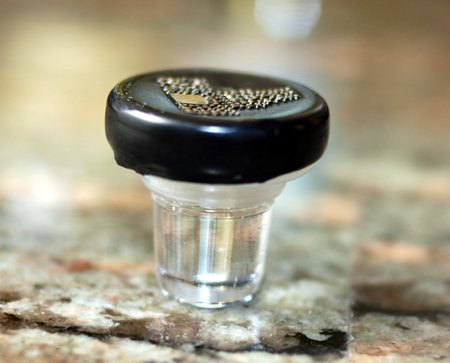 But
change has come slowly. The rather elegant glass
stoppers made by Alcoa Germany (left) work
very well, but the bottle itself has to be
specially made to accept them. Napa
Valley’s Whitehall Lane uses them, as do many
German wineries.
But
change has come slowly. The rather elegant glass
stoppers made by Alcoa Germany (left) work
very well, but the bottle itself has to be
specially made to accept them. Napa
Valley’s Whitehall Lane uses them, as do many
German wineries.
In Europe premium wines still use cork, but even there producers are testing the waters with alternative stoppers.
I believe it’s only a matter of time before synthetic corks or screw caps replace real corks in wine bottles. And when true wine lovers begin to admit that corked wines can be an expensive way to fake romance with the pop of a cork, the change-over will come quickly.
❖❖❖

 "So long, farewell auf
wiedersehen, adieu,
"So long, farewell auf
wiedersehen, adieu,
Adieu, adieu, to
yieu and yieu and yieu!"
"Unlike McNally’s two-decades-old Balthazar, a bistro
machine that churns out the Napoleonic ideal of steak
frites night after night, Augustine hasn’t quite got the
food down. But what it lacks in consistency it makes up
for in kindness. Roberta’s mere presence, as she
delivers the tarte tatin, a rose of butter-caramel apple
slices hugging a hazelnut crust, rescues the experience
from the dispassion of the suits—as does François’s wink
and pour of gifted Calvados. You might forget the food,
but you’ll feel like family exiting to a heartfelt
chorus of `À la prochaine' and `Ciao, ciao!'" –Becky Cooper,
“Augustine,” The
New Yorker (April 3, 2107).
Any of John Mariani's books below may be ordered from amazon.com.
 The
Hound in Heaven (21st Century Lion Books)
is a novella, and for anyone who loves dogs,
Christmas, romance, inspiration, even the supernatural, I
hope you'll find this to be a treasured favorite.
The story concerns how, after a New England teacher,
his wife and their two daughters adopt a stray puppy found
in their barn in northern Maine, their lives seem full of
promise. But when tragedy strikes, their wonderful dog
Lazarus and the spirit of Christmas are the only things
that may bring his master back from the edge of
despair.
The
Hound in Heaven (21st Century Lion Books)
is a novella, and for anyone who loves dogs,
Christmas, romance, inspiration, even the supernatural, I
hope you'll find this to be a treasured favorite.
The story concerns how, after a New England teacher,
his wife and their two daughters adopt a stray puppy found
in their barn in northern Maine, their lives seem full of
promise. But when tragedy strikes, their wonderful dog
Lazarus and the spirit of Christmas are the only things
that may bring his master back from the edge of
despair. WATCH THE VIDEO!
“What a huge surprise turn this story took! I was completely stunned! I truly enjoyed this book and its message.” – Actress Ali MacGraw
“He had me at Page One. The amount of heart, human insight, soul searching, and deft literary strength that John Mariani pours into this airtight novella is vertigo-inducing. Perhaps ‘wow’ would be the best comment.” – James Dalessandro, author of Bohemian Heart and 1906.
“John Mariani’s Hound in Heaven starts with a well-painted portrayal of an American family, along with the requisite dog. A surprise event flips the action of the novel and captures us for a voyage leading to a hopeful and heart-warming message. A page turning, one sitting read, it’s the perfect antidote for the winter and promotion of holiday celebration.” – Ann Pearlman, author of The Christmas Cookie Club and A Gift for my Sister.
“John Mariani’s concise, achingly beautiful novella pulls a literary rabbit out of a hat – a mash-up of the cosmic and the intimate, the tragic and the heart-warming – a Christmas tale for all ages, and all faiths. Read it to your children, read it to yourself… but read it. Early and often. Highly recommended.” – Jay Bonansinga, New York Times bestselling author of Pinkerton’s War, The Sinking of The Eastland, and The Walking Dead: The Road To Woodbury.
“Amazing things happen when you open your heart to an animal. The Hound in Heaven delivers a powerful story of healing that is forged in the spiritual relationship between a man and his best friend. The book brings a message of hope that can enrich our images of family, love, and loss.” – Dr. Barbara Royal, author of The Royal Treatment.
 |
The Encyclopedia of American Food and Drink by John F. Mariani (Bloomsbury USA, $35) Modesty forbids me to praise my own new book, but let me proudly say that it is an extensive revision of the 4th edition that appeared more than a decade ago, before locavores, molecular cuisine, modernist cuisine, the Food Network and so much more, now included. Word origins have been completely updated, as have per capita consumption and production stats. Most important, for the first time since publication in the 1980s, the book includes more than 100 biographies of Americans who have changed the way we cook, eat and drink -- from Fannie Farmer and Julia Child to Robert Mondavi and Thomas Keller. "This book is amazing! It has entries for everything from `abalone' to `zwieback,' plus more than 500 recipes for classic American dishes and drinks."--Devra First, The Boston Globe. "Much needed in any kitchen library."--Bon Appetit. |
"Eating Italian will never be the same after reading John Mariani's entertaining and savory gastronomical history of the cuisine of Italy and how it won over appetites worldwide. . . . This book is such a tasteful narrative that it will literally make you hungry for Italian food and arouse your appetite for gastronomical history."--Don Oldenburg, USA Today. "Italian
restaurants--some good, some glitzy--far
outnumber their French rivals. Many of
these establishments are zestfully described
in How Italian Food Conquered the World, an
entertaining and fact-filled chronicle by
food-and-wine correspondent John F.
Mariani."--Aram Bakshian Jr., Wall Street
Journal.
"Equal parts
history, sociology, gastronomy, and just
plain fun, How Italian Food Conquered the
World tells the captivating and delicious
story of the (let's face it) everybody's
favorite cuisine with clarity, verve and
more than one surprise."--Colman Andrews,
editorial director of The Daily
Meal.com. "A fantastic and fascinating
read, covering everything from the influence
of Venice's spice trade to the impact of
Italian immigrants in America and the
evolution of alta cucina. This book will
serve as a terrific resource to anyone
interested in the real story of Italian
food."--Mary Ann Esposito, host of PBS-TV's
Ciao
Italia. "John Mariani has written the
definitive history of how Italians won their
way into our hearts, minds, and
stomachs. It's a story of pleasure over
pomp and taste over technique."--Danny Meyer,
owner of NYC restaurants Union Square
Cafe, The Modern, and Maialino.
|
 |
 |
 |
 |
 |
 |
 |
 |
 Everett Potter's Travel Report:
Everett Potter's Travel Report: 
 Eating Las Vegas
JOHN CURTAS has been covering the Las Vegas
food and restaurant scene since 1995. He is
the co-author of EATING LAS VEGAS – The 50
Essential Restaurants (as well as
the author of the Eating Las Vegas web site: www.eatinglasvegas.
He can also be seen every Friday morning as
the “resident foodie” for Wake Up With the
Wagners on KSNV TV (NBC) Channel 3 in
Las Vegas.
Eating Las Vegas
JOHN CURTAS has been covering the Las Vegas
food and restaurant scene since 1995. He is
the co-author of EATING LAS VEGAS – The 50
Essential Restaurants (as well as
the author of the Eating Las Vegas web site: www.eatinglasvegas.
He can also be seen every Friday morning as
the “resident foodie” for Wake Up With the
Wagners on KSNV TV (NBC) Channel 3 in
Las Vegas.

MARIANI'S VIRTUAL GOURMET
NEWSLETTER is published weekly. Editor/Publisher: John
Mariani.
Editor: Walter Bagley. Contributing Writers: Christopher Mariani,
Robert Mariani, Misha Mariani, John A. Curtas, Geoff Kalish, Mort
Hochstein, and
Brian Freedman. Contributing Photographers: Galina
Dargery. Technical Advisor: Gerry McLoughlin.
To un-subscribe from this newsletter,click here.
© copyright John Mariani 2017

